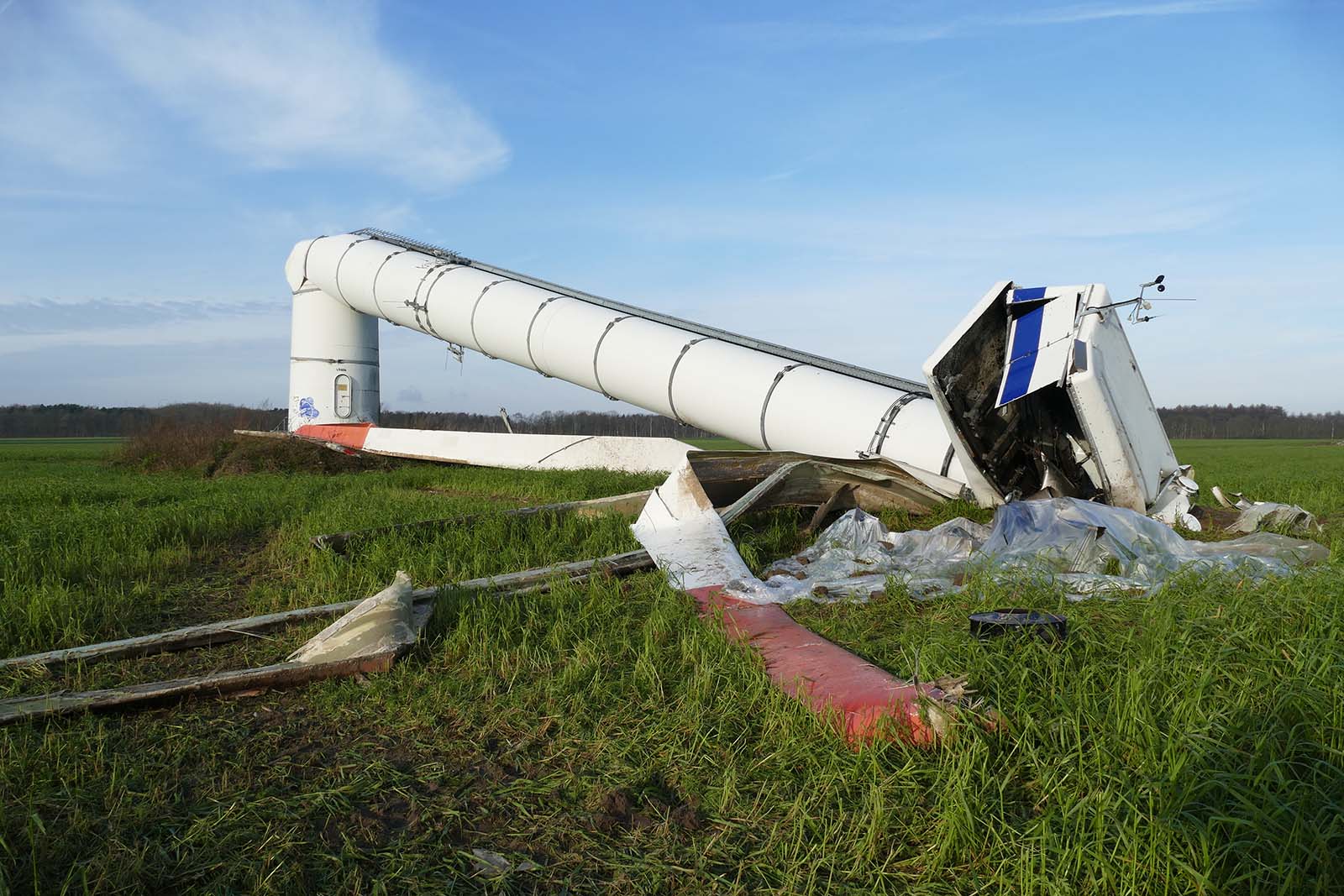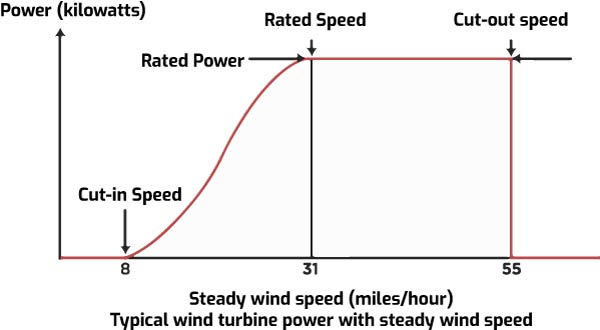How To Protect Your Wind Turbine
Interested in this FREE data set?
For wind farms, extreme winds pose risks, but also opportunities. An overview of the risks and benefits of extreme winds to renewable wind energy facilities.
Wind energy facilities face weather-related risks in every aspect of their business. This article explores how extreme weather poses risks to wind farm operations, especially offshore facilities, and looks at weather prediction strategies for mitigating those risks. We also look at the positive aspects of extreme winds and storms: how they can result in high energy generation.
Hazards posed to turbines by extreme wind
According to a 2017 study Wind Turbine Accidents: A Data Mining Study, natural events were the largest contributor to global wind turbine accidents, slightly beating human factors or mechanical failures. An “accident” was defined as a publicly-reported incident resulting in human or equipment injury. The majority of wind turbine accidents caused by nature happened during the operations stage, rather than transport, construction, or maintenance.
Distribution Of Reasons For Accidents Caused By Nature
| Cause | Count |
| Nature (strong wind) | 32 |
| Nature (lightning strike) | 9 |
| Nature (storm) | 4 |
| Nature (other) | 3 |
| Nature (cyclone) | 2 |
| Nature (tornado) | 2 |
| Nature (cold) | 1 |
| Nature (due to collision) | 1 |
| Nature (strong wind, lightning strike) | 1 |
| Nature (strong wind, snow) | 1 |
| Structural (bolt failure) | 1 |
| Structural (smashed barge) | 1 |
| Credit: Table from 2017 wind turbine study | |

Strong winds were found to be the leading cause of damage (lightning was second). Here’s a video of a wind turbine in Djursland, Denmark being destroyed by strong winds during a storm. In this case, the safety breaker had a malfunction.
There are many videos showing turbines being destroyed from spinning too fast.

Credit: Office of Energy Efficiency & Renewable Energy: How do wind turbines survive severe storms?
Typical wind turbines begin generating energy at wind speeds around 8mph (the “cut-in speed”). Most turbines are rated to achieve peak performance at a steady wind speed of approximately 30mph. When winds exceed 55 MPH, a braking system brings the rotor to a standstill to avoid turbine damage. During such high wind events the blades are also “feathered,” i.e. oriented so that they no longer catch the wind and cease rotation.
Failure to apply brakes or feather the blades at the right time in high wind events can lead to a number of potentially catastrophic outcomes, such as:
- Blades or pieces of blades becoming airborne. Pieces of blades have been documented as traveling up to one mile.
- Turbine fire. Overloading of turbines can result in extensive damage to nacelle components.
- Total destruction of the tower.
Climate change and other extreme weather risks
In a 2019 article about the hazards posed by windstorms to offshore wind farms, they cite a study by Robinson et al that warns that “windstorm risk in the United Kingdom will likely rise due to climate change, resulting in a subsequent increase in future insured losses […]”
Related to climate change effects, a study by Rose et al “painted an alarming picture of the potential hurricane risk for wind farms in the Atlantic and Gulf coastal waters of the United States, with nearly half of the wind turbines likely to be destroyed over a 20‐year period.”
Apart from wind, there can be other extreme weather events that harm turbines. The 2021 winter storm in U.S. showed one example, with unexpectedly cold weather causing turbines in Texas and other states to malfunction and shut down. Turbines can be made with safety mechanisms for such situations (for example, defrosting capabilities) but as this was unusual weather for these areas, these turbines did not have such features. (This can be seen as tangentially related to climate change, as one of the predicted effects is extreme and unusual weather.)
How can risks be mitigated with better forecasting?
All of these negative impacts we’ve examined can be mitigated with better weather forecasting.
For damage caused by turbines spinning too fast, there can be various automatic shutdowns or lockdowns that turbines can have in place. But some of these may not be enough to avoid all damage. For example, some turbines have automatic shutdowns for 100 MPH winds, but damage can happen at significantly lower wind speeds. Also, some older or less advanced facilities may not have these automatic shutdown protocols in place.
With accurate forecasts of upcoming problematic wind, facilities could manually lock down turbines to avoid potential damage. With predictive modeling of wind events, overload of turbines and blades can be prevented more effectively than by reliance on automatic braking and feathering mechanisms. Preemptive action provides a higher degree of security than relying on sensor technology that only responds (or doesn’t) at the moment it’s needed.
Let’s take a closer look at Storm Bella
Make sure to download a free data sample sample collected during Storm Bella.
Strong winds present opportunities
Strong winds aren’t all bad, of course. Assuming damage can be avoided, strong winds mean more energy production.
The 2020 winter storm Bella was one example of this. Bella was of course a devastating storm, with gusts exceeding 100 MPH, and it had many bad effects. But for the wind energy sector, there were some positives. As a Guardian headline pointed out, “Storm Bella helps Great Britain set new record for wind power generation.” Specifically, “As Storm Bella arrived […] wind provided 50.7% of Great Britain’s electricity according to data charting the power generation mix. While wind briefly hit 60% in August, it had not previously sustained such levels for 24 hours.”
Below is a visualization of Spire Weather forecasts at 80m wind turbine heights (Spire also provides wind forecasts at 100m and 120m):
Wind Speed (m/s) at 80 Meters AGL from December 25th 2020 until December 27th 2020
Companies will increasingly invest in tougher turbine technology that will be more resistant to weather damage, which will allow them to better take advantage of stronger winds. For one example of this, a BBC article describes “a start-up called Challenergy, based in Tokyo [that] has designed and built a wind turbine specifically engineered to operate in typhoon-prone areas.”
And wind farm operators will increasingly analyze the risks of turbine damage versus the rewards of harnessing more wind in order to find the “sweet spot” for placement of wind farms, and to find optimal operating protocols for operating in high winds.
Looking toward the horizon
The increase in renewable energy demand will mean increasing demand for accurate, long- and short-range weather forecasting.
To take one example: floating wind farms are in active development. These mobile units offer the ability to move to take advantage of more constant and strong winds:
“Off the east coast of Scotland, in water more than 300 feet deep, five towering turbines weighing thousands of tons float in the North Sea. Installed in 2017, the turbines power about 36,000 homes a year. Wind farms have been erected on land and at sea for decades, but Hywind Scotland, operated by Norwegian oil giant Equinor AS A, is the first to float.”
Credit: Wall Street Journal
Share on Facebook Share on Twitter Share on LinkedIn
But the benefits of mobile units mean that they’re subject to even greater threats from extreme weather and storms, making weather prediction even more important. Mobile turbine units will need to move to avoid storms and bad conditions. This is already done with oil rigs. Moving oil rigs is costly, but of course that’s preferable to letting the rig be damaged by a storm. The same will be the case for floating wind turbines.
Support infrastructure for energy transmission and transportation will also be at greater risk in deep water operations. As turbines get bigger and move further offshore, they become even more vulnerable to extreme natural events, and weather prediction becomes not just a valuable adjunct to daily operations but a dire necessity.
Also, taller wind turbines are being created that take advantage of higher altitude winds that have more power. And airborne wind units attempt to harness those powerful winds also. For all companies trying to harness more powerful wind, finding more accurate and higher resolution weather forecasts will be increasingly important.